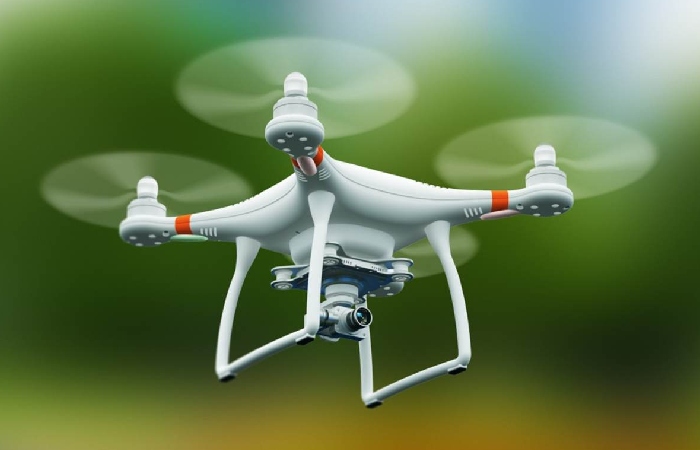All About Drone
 Drones, also known as crewless aerial vehicles (UAVs), are remotely operated or autonomously piloted aircraft that have recently gained significant popularity. They come in various sizes and types, from small recreational drones to larger commercial and military-grade UAVs. Here’s some information about drones:
Drones, also known as crewless aerial vehicles (UAVs), are remotely operated or autonomously piloted aircraft that have recently gained significant popularity. They come in various sizes and types, from small recreational drones to larger commercial and military-grade UAVs. Here’s some information about drones:
Types of Drones:
- Recreational Drones: These drones are commonly used for personal enjoyment, aerial photography, and videography. They are typically lightweight, easy to operate, and affordable.
- Commercial Drones: These drones user for various professional purposes, such as aerial photography, videography, surveying, mapping, agriculture, inspections, and more. They are often equipped with advanced features and high-quality cameras.
- Military Drones: Military drones are used for reconnaissance, surveillance, and combat operations. They can either remotely piloted or operate autonomously, and they often have advanced capabilities like weapon systems and long-flight endurance.
- Delivery Drones: Designed for logistics and transportation, delivery drones use by companies to transport packages and goods over short distances. They are test for various applications, including e-commerce deliveries and medical transport.
Components of a Drone:
- Frame: The structure or body of the drone that holds all the components together.
- Motors and Propellers: Electric motors and propellers provide the necessary thrust and lift to keep the drone airborne.
- Flight Controller: The brain of the drone, which processes commands and adjusts the motors’ speed to control the drone’s flight.
- Battery: Drones are typically powered by rechargeable lithium-polymer (LiPo) batteries, providing the necessary electrical energy for flight.
- Sensors and Navigation Systems: Drones use GPS, accelerometers, gyroscopes, and barometers to maintain stability, navigate, and gather data.
- Camera and Gimbal: Many drones equip with cameras for aerial photography and videography. A gimbal stabilizes the camera and reduces unwanted vibrations, resulting in smooth footage.
- Transmitter and Receiver: Remote control transmitters allow the pilot to control the drone wirelessly while the receiver on the drone receives the commands.
- Onboard Computer and Software: Advanced drones may have onboard computers running specialized software to process data, enable autonomous flight, and perform complex tasks.
Regulations and Safety:
- Different countries have varying regulations regarding drone operations. These regulations typically cover registration, licensing, flight restrictions, and privacy concerns. Therefore, it’s essential to familiarize yourself with the rules in your area before flying a drone.
- Safety precautions should follow when operating a drone, including maintaining line of sight, avoiding restricted airspace, respecting privacy, and flying responsibly. In addition, pre-flight checks, such as inspecting the drone, batteries, and propellers, are essential for safe operations.
- Drones should not fly drones near airports, helipads, or other areas where aircraft operate. Again, it’s crucial to respect airspace regulations and prioritize the safety of human-crewed aircraft.
Advantages and Applications:
- Aerial Photography and Videography: Drones offer unique perspectives and angles for capturing stunning photos and videos.
- Surveying, Mapping, and Inspections: Drones can quickly and cost-effectively survey large areas, create accurate maps, and inspect infrastructure such as buildings, power lines, and pipelines.
- Agriculture: Drones equipped with specialized sensors can monitor crop health, optimize irrigation, and spray pesticides precisely, resulting increase efficiency and reduced costs.
- Search and Rescue: Drones with thermal cameras and other sensors can aid search and rescue operations by locating missing persons or providing situational awareness in hazardous environments.
- Environmental Monitoring: Drones enable researchers to monitor
How to Submit Your Articles?
Meant for Submitting Your Articles, you can email us at contact@themarketingpilot.com
Why Write for The Marketing Pilot – Drone Write for Us
 If you write to us, your company will be targeted, and readers of our site will be able to read your article, giving you a lot of publicity.
If you write to us, your company will be targeted, and readers of our site will be able to read your article, giving you a lot of publicity.
- Building relationships with your intended audience will be facilitated by this.
- If you write for us, your brand will have global visibility.
- We share your article on social media as part of our social media presence.
- You can consist of a link to your website in the post, which will benefit both of their SEO.
Search Terms Related to Drone Write for Us
Drone write for us free
photography write for us
drone websites
write for us general
drone news 2022
drones magazine
drone blog
drone articles
Search Terms for Drone Write for Us
write for us
guest post
contributor guidelines
looking for guest posts
become a guest blogger
guest posts wanted
writers wanted
guest posting guidelines
become an author
guest posts wanted
submit post
suggest a post
write for us
guest post
contributor guidelines
contributing writer
Advertising Audience and also
Advertising Banners
Guidelines of the Article Drone Write for Us
 However, you can send your article to contact@themarketingpilot.com
However, you can send your article to contact@themarketingpilot.com
